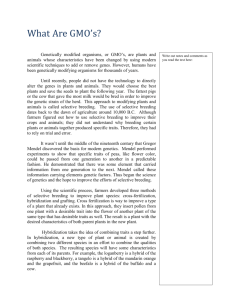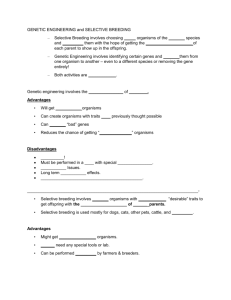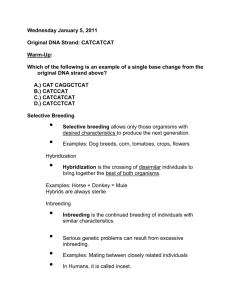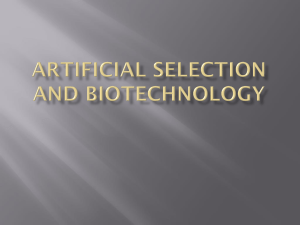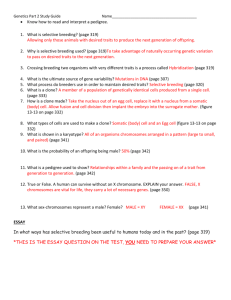printer-friendly version of benchmark
advertisement
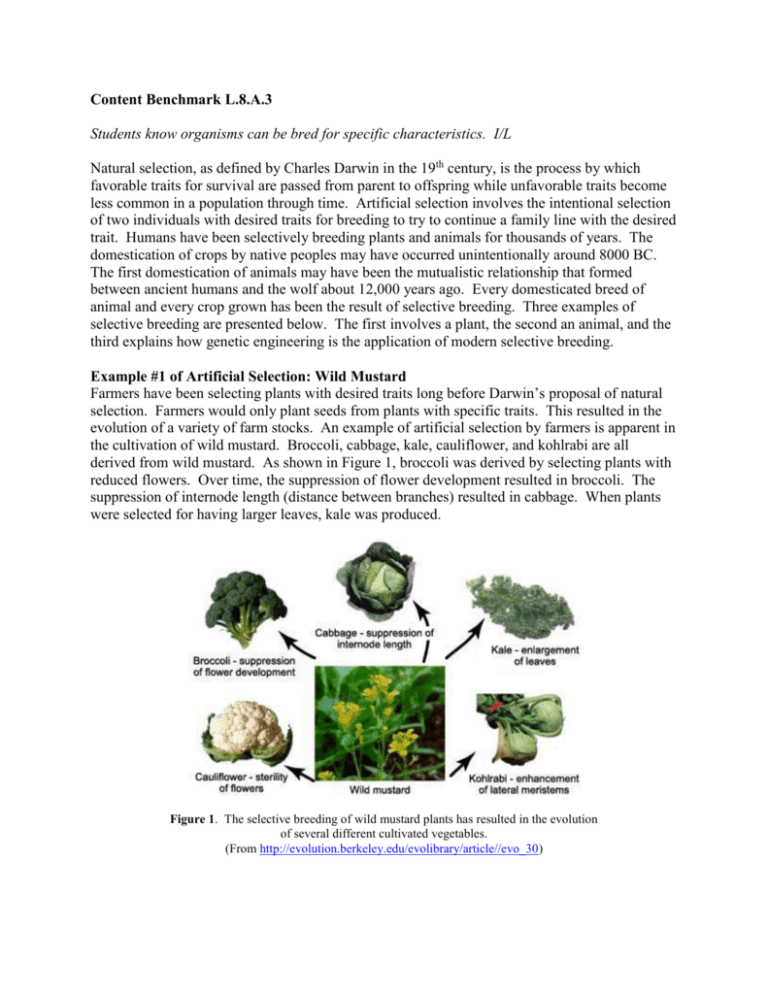
Content Benchmark L.8.A.3 Students know organisms can be bred for specific characteristics. I/L Natural selection, as defined by Charles Darwin in the 19th century, is the process by which favorable traits for survival are passed from parent to offspring while unfavorable traits become less common in a population through time. Artificial selection involves the intentional selection of two individuals with desired traits for breeding to try to continue a family line with the desired trait. Humans have been selectively breeding plants and animals for thousands of years. The domestication of crops by native peoples may have occurred unintentionally around 8000 BC. The first domestication of animals may have been the mutualistic relationship that formed between ancient humans and the wolf about 12,000 years ago. Every domesticated breed of animal and every crop grown has been the result of selective breeding. Three examples of selective breeding are presented below. The first involves a plant, the second an animal, and the third explains how genetic engineering is the application of modern selective breeding. Example #1 of Artificial Selection: Wild Mustard Farmers have been selecting plants with desired traits long before Darwin’s proposal of natural selection. Farmers would only plant seeds from plants with specific traits. This resulted in the evolution of a variety of farm stocks. An example of artificial selection by farmers is apparent in the cultivation of wild mustard. Broccoli, cabbage, kale, cauliflower, and kohlrabi are all derived from wild mustard. As shown in Figure 1, broccoli was derived by selecting plants with reduced flowers. Over time, the suppression of flower development resulted in broccoli. The suppression of internode length (distance between branches) resulted in cabbage. When plants were selected for having larger leaves, kale was produced. Figure 1. The selective breeding of wild mustard plants has resulted in the evolution of several different cultivated vegetables. (From http://evolution.berkeley.edu/evolibrary/article//evo_30) Example #2 of Artificial Selection: Dogs The domestication of dogs is an example of selective breeding in animals. All domesticated dogs are the same species (Canis familiaris) but exhibit incredible variation from the tiny Chihuahua to the enormous St. Bernard, from the hairless Chinese Crested Terrier to the long haired English Sheepdog, and from the intelligent Border Collies to the challenged Irish Setters. Recent mitochondrial DNA analysis suggests that wolves split into two lines about 100,000 years ago (http://www.idir.net/~wolf2dog/wayne1.htm). One line was the wolf ancestors which led to modern dogs. Domestication of these “wolf” dogs occurred about 15,000 years ago. The relationship of humans with dogs was probably accidental. About this time, it is believed that humans were giving up their nomadic lifestyles and staying at semi-permanent campsites. Wolfdogs probably started hanging around these campsites scavenging food. Over time, social dogs integrated into human society. Humans then started selecting for more sociable dogs and dogs eventually became “man’s best friend.” Currently, there are up to 800 breeds of dogs recognized by various kennel clubs. All of these breeds originated from the same wolf-dog ancestor. Humans have routinely chosen the parent dogs for breeding because of the traits that they possessed. It was well known that the puppies had a good chance to be born with the desired trait. The puppies that did not possess the desired traits were not bred in the next generation. These breeding techniques were being practiced before the concept of the gene was understood. Gregor Mendel and others have since explained how the existence of different forms of a gene can produce puppies with unexpected trait combinations. An example of selective breeding in dogs is one of the smallest breeds, Daschunds. In this case, the traits that were selected for were small size and short legs. After many generations, a dog breed capable of following small prey like foxes, badgers, and rabbits into burrows and flushing them out into the open for hunters was produced. The Great Dane is another result of selective breeding. These dogs were created by selecting for their large, heavy size. They were used for hunting, protection, and fighting. Dog breeds were created by selecting traits that would help humans hunt, work herds, protect property, be status symbols, to race, and to be companions. For a downloadable handout that explains the mechanism of artificial selection of dogs visit http://www.middleschoolscience.org/Download/artselect.doc. Figure 2. Artificial selection of dog breeds has resulted in many different types of dogs. (From http://evolution.berkeley.edu/evosite/lines/IVAartselection.shtml) Example #3 of Artificial Selection: Genetic Manipulation While selective breeding continues in plants and animals by farmers and breeders, modern selective breeding techniques involve modifying the organism’s genome (DNA). A genetically modified organism (GMO) has a gene for a desired trait manually inserted into its genome. The magnitude of genetic change in genetically modified organisms is very different than its natural variety. Figure 3 illustrates how a natural genetic change is different in method and magnitude of genetic change. Plants and seeds (A) consist of many cells (B). Chromosomes in the cell (C) contain DNA molecules (D) that store genetic information. Millions of individual nucleotides make up the DNA information in a single cell. With GMOs, new genes are introduced into the cell (E) that could come from any living thing. This gene will contain the information to control a desired trait. The transgene inserts into the plant's chromosome (F) and becomes a permanent addition to the genetic information in the plant. With non-GMO crops, changes as minor as a single nucleotide change (G) in an existing gene create a new version of the gene (H) that controls a new trait in the plant. These changes can occur from natural mistakes in DNA replication or be induced by chemical treatments. University of Nebraska Agricultural Research Division (ARD) is the major research agency of the University of Nebraska's Institute of Agriculture and Natural Resources and is Nebraska's Agricultural Experiment Station. ARD scientists improve the quality of life for Nebraskans across the state. They make important contributions to the state's agriculture, food industries, environment, the well-being of families, and community development. This site can be accessed at http://cropwatch.unl.edu/. Figure 3. Genetic modification vs. natural genetic changes. (From http://cropwatch.unl.edu/) Currently, this technique is used commercially in plants and only experimentally in animals. This technique is very controversial and cutting edge at the same time. Supporters say that genetically modified foods could end world hunger while critics say the risks are still unknown and warns of “super pests” (genetic changes resulting in unwanted traits). The most common products derived from genetically modified crops are soybeans, corn, canola oil, cotton seed oil, and wheat. Current estimates say that 60% of processed food contains genetically modified ingredients (http://encarta.msn.com/encnet/features/guides/?article=GMOmain). Genetic modification has resulted in rice with an inserted vitamin A gene. This rice was created to reduce blindness in poor countries that suffer from vitamin A deficiency. A variety of GMO fruits and vegetables have inserted genes to slow decomposition. Thus, increasing shelf life and reducing financial loss due to rotting fruit. The future of GMO may result in fruit with vaccines for childhood diseases, plants more resistant to drought and frost (lengthening the growing seasons), or potatoes that absorb less fat when fried. The products “invented” using this technology may be unlimited. The future of GMOs may also involve livestock. The Food and Drug Administrations recently has determined that meat and milk from cow, pig, and goat clones are safe to include in the food supply (http://www.fda.gov/cvm/cloning.htm). The first approved genetically modified animal for US consumer markets may be the Aqua Bounty salmon. This salmon variety has a growth-hormone gene inserted from the Chinook salmon. The modified Aqua Bounty salmon reaches market weight in about 18 months instead of 30. For additional information on transgenic or GMO livestock visit http://migration.ucdavis.edu/rmn/more.php?id=1253_0_5_0 Critics are rightfully concerned about the formation of super weeds, new diseases, and other unanticipated result of genetic manipulation. Critics are especially concerned about this technique being applied to animals, including humans, as the result may be cruel to the resulting individual. The worst case scenario that critics warn about is that science may create a new organism that spawns a fatal epidemic. Students should be introduced to GMOs because it is current, controversial, and will make them more informed consumers. It will continue to be a controversial issue in American politics as the United States currently produces over 60% of the world’s GMO crops, Figure 4. Figure 4. Global breakdown of growers of genetically modified crops. (From http://www.itmonline.org/arts/gmo.htm) For an overview of genetic modified organisms, the controversies surrounding this technology, and links for additional links for more information visit http://www.ornl.gov/sci/techresources/Human_Genome/elsi/gmfood.shtml The following link, titled the GMO Compass, is a news website covering current GMO issues worldwide, especially in Europe. “This website project is financially supported by the European Union. GMO Compass is the work of independent science journalists.” http://www.gmo-compass.org/eng/home/ Content Benchmark L.8.A.3 Students know organisms can be bred for specific characteristics. I/L Common misconceptions associated with this benchmark 1. Students incorrectly think that evolution has not been observed. While the mechanism may not be natural, artificial selection does result in the accumulation of minor genetic changes. Over time, these changes may culminate in the formation of a new species. Humans have been using selective breeding practices for a relatively short period of time (when compared to an evolution timeline). Therefore, we have created a multitude of variations of livestock and crops but they have not reached the level of a new species. All domestic dogs are still the same species even though the breeds may look very different. Another 100,000 years, we may see many species of domestic dogs incapable of interbreeding. The following link is an article about microevolution due to artificial selection under lab conditions. http://evolution.berkeley.edu/evosite/evo101/IVB1bInthelab.shtml The following link is another article on evolution by artificial selection. http://www.zoo.utoronto.ca/able/volumes/vol-21/8-lauffer.pdf 2. Students incorrectly think that two different species can be crossed to create new species. This misconception goes back to the old jokes “What do you get if you cross an elephant with a kangaroo? Holes all over Australia.” Students have a weak understanding of the concept of a species. While hybridization does occur, a viable offspring is not produced. Therefore, the parents are not the same species. A horse can be bred with a donkey and produce a mule. However, the mule is sterile. Artificial selection only involves two individuals of the same species that are chosen for specific traits to produce desired offspring. 3. Students do not understand both parents contribute genes for each characteristic. They believe that one parent contributes genes for some characteristics, while the other features come from the other parent. Mendelian inheritance is the mode of inheritance for nearly all multicellular organisms. Inheritance is controlled by genes, which are passed on to the offspring in the same form as they were inherited from the previous generation. For each trait, an individual has two genes, one inherited from its father and the other from its mother. The two genes are represented in equal proportions in its gametes. For additional information on inheritance see TIPS Benchmark L.8.A.1. More details about gamete formation visit http://www.biology.arizona.edu/CELL_BIO/tutorials/meiosis/main.html 4. Students believe that inherited traits are blended. Blending inheritance is the erroneous idea that organisms contain a blend of their parent hereditary factors and pass that blend on to their offspring. Inheritance of certain traits like hair color, eye color, and skin tone are all controlled by multiple alleles, therefore, allowing for variation in color. Incomplete dominance results in an intermediate (third) phenotype. Although these traits appear to be a blend of inherited traits, they are not. Each trait in an offspring is still determined by the relationship of the genes (allele) inherited from each parent. Content Benchmark L.8.A.3 Students know organisms can be bred for specific characteristics. I/L Sample Test Questions 1. The existence of the incredible variation of domesticated animals is due to a. Natural selection b. Artificial selection c. Mendelian selection d. Random chance 2. A controversial technology that involves plugging a gene for a desired trait into the genome of another organism is called a. gene slicing b. natural selection c. genetic modification d. genetic deletion Figure 5. Pictures of breeds. (From http://www.akc.org) 3. Evidence shows that the wolf is the ancestor to all of the breeds of dogs shown in Figure 5. How did this variation arise in a relatively short period of time? a. Genetic manipulation b. Natural selection c. Random chance d. Selective breeding Content Benchmark L.8.A.3 Students know organisms can be bred for specific characteristics. I/L Answers to Sample Test Questions 1. (b) 2. (c) 3. (d) Content Benchmark L.8.A.3 Students know organisms can be bred for specific characteristics. I/L Intervention Strategies and Resources The following is a list of intervention strategies and resources that will facilitate student understanding of this benchmark. 1. Performance activity “Does Selective Breeding Change a Species?” This is an activity where students analyze the characteristics of female rabbits and choose which doe would be most likely to produce desired traits in their offspring. This activity is appropriate for upper level middle school or as an enrichment activity. To access this lesson plan visit http://www.slc.k12.ut.us/staff/larmad/science/Link%20Files/Biology_Details/Lessons/0402P erfTest.pdf 2. Dragon Genetics Software for this activity can be downloaded from the website below. This activity is appropriate for students that have an understanding of alleles, genotypes, and phenotypes. In the downloaded full version, students have the opportunity to cross individuals and see the resulting offspring. This activity’s hook is using dragons as the organism of interest. Students are always interested in these mythological creatures so they are more likely to be on task. This program can be accessed at http://biologica.concord.org/webtest1/web_labs_genophenotype.htm 3. Web Quest on genetically modified food This web quest asks students to read and research several websites on genetically modified food. Students then need to decide if they agree or disagree with genetically modifying food and write a statement that supports their opinion. Students then post their opinion to a “guestbook” where they can read other students’ opinions. To access this web quest follow this link http://web.syr.edu/~smsmit06/genetics-teacher.htm

